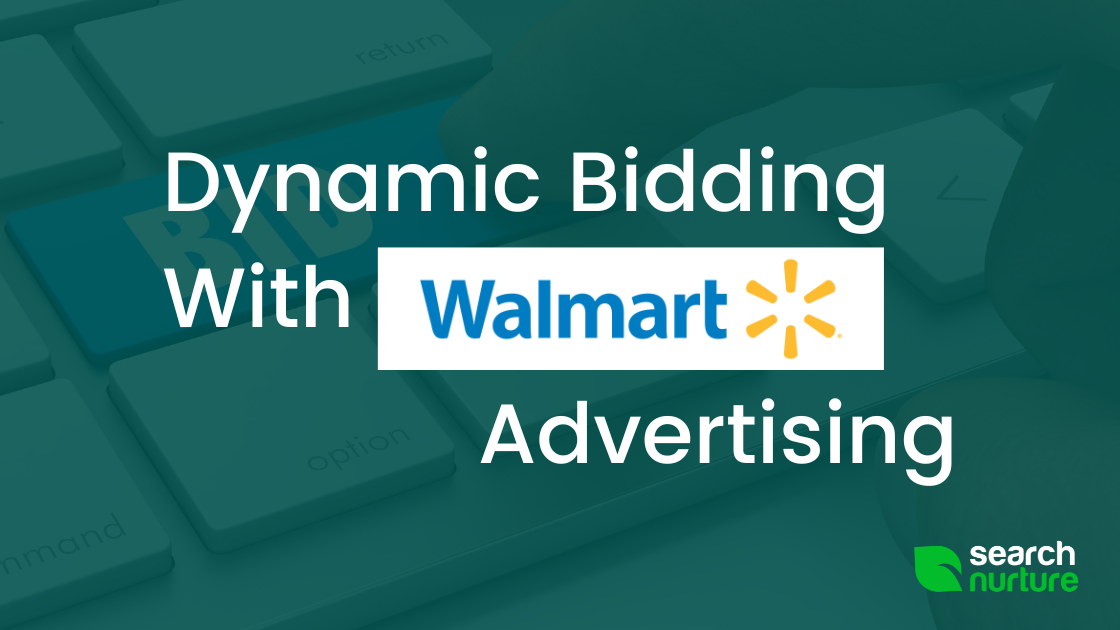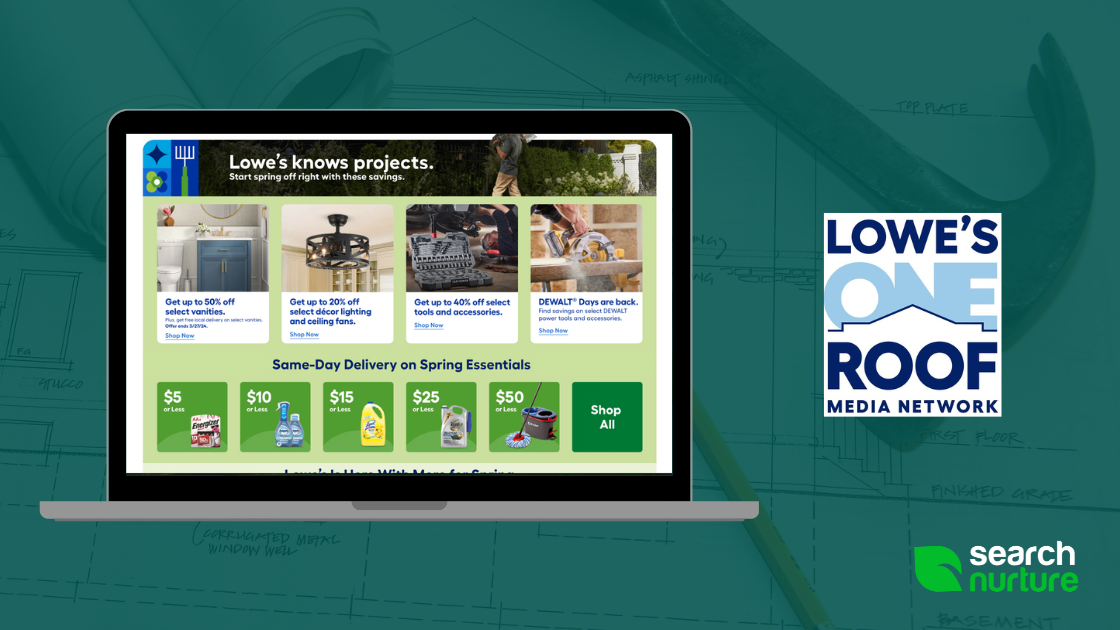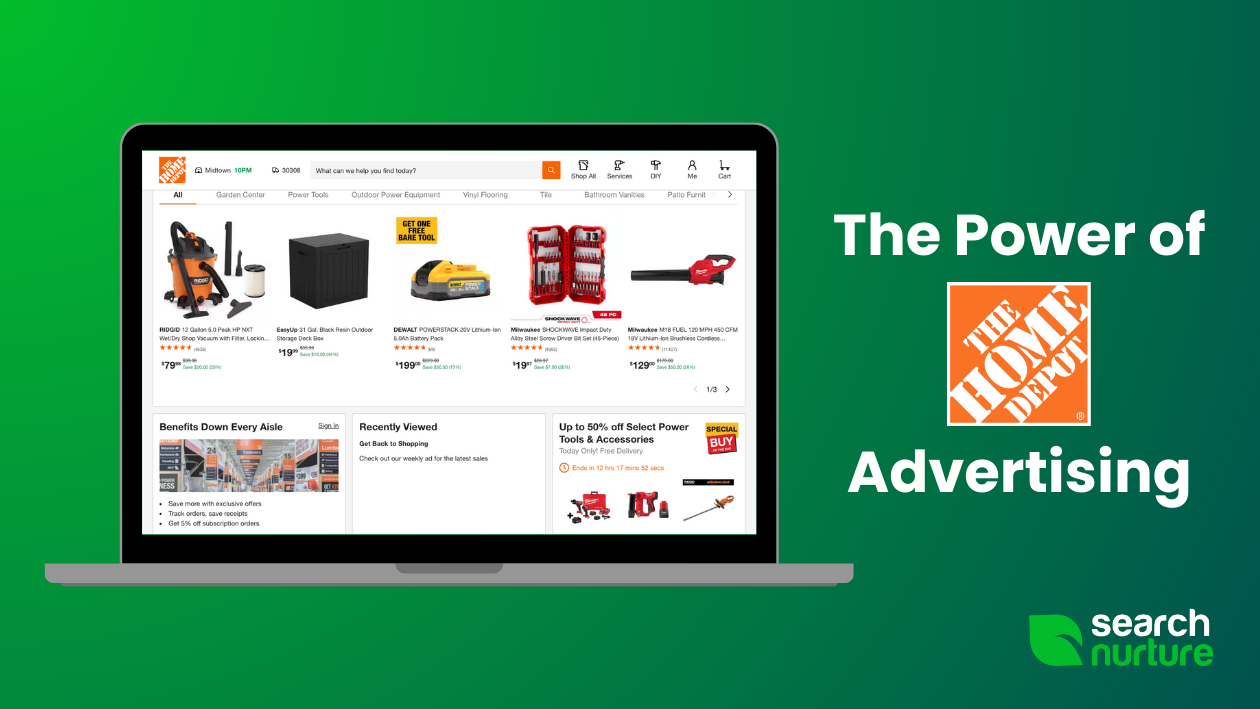You’re hearing about all the success brands have with Home Depot advertising. So, you sign up to join the Home Depot Retail Media+ network, spend some money on ad placements for all your products, and sit back and wait for the sales to roll in.
The problem is… the sales are not rolling in.
Why is that? Well, with all of the different advertising features Retail Media+ has to offer, some entrepreneurs think that, like magic, they’ll start seeing a great return on their ad spend. But advertising rarely involves a “throw spaghetti on the wall and see what sticks” approach. To have success, you need to fine-tune your Home Depot advertising strategy.
My team has built custom Home Depot advertising campaigns for several clients, and we’ve learned a lot over the last few years. In this article, I’m spilling a few secrets our team uses to make your Home Depot marketing strategy more profitable.
Determine Your Home Depot Advertising Goals
Your goal is to sell your products on Home Depot—but that goal is too broad.
Behind every high-performing advertising campaign is a set of clearly defined objectives. Whether those aspirations are to boost sales, increase brand visibility, or optimize ad spending, your goals will direct the course of your strategies.
Let’s start with a quick definition of the most important ad metrics, from your friendly neighborhood advertising experts:
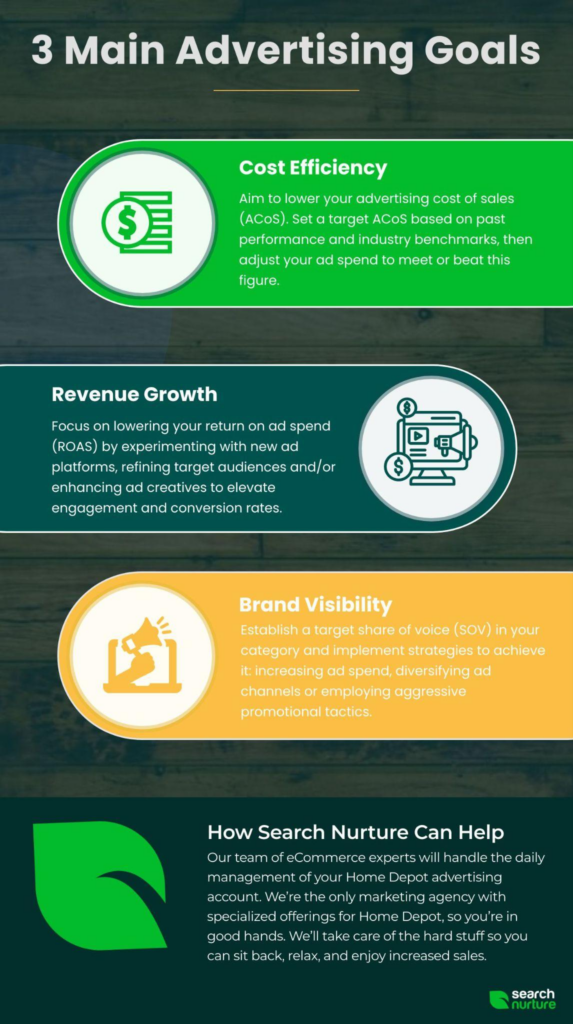
- Advertising Cost of Sales (ACoS): Measures the cost efficiency of your advertising campaign by calculating the ratio of ad spend to sales revenue. It answers the question, “How much are we spending to achieve a dollar in sales?
- Return on Ad Spend (ROAS): Measures the overall return generated from your advertising investment, answering the question, “For every dollar spent on advertising, how much revenue are we bringing in?”
- Share of Voice (SOV): Reflects the proportion of visibility that your brand gains compared to that of your competitors within the same product category. The higher your SOV, the greater your top-of-mind awareness, which drives customer trust and, ultimately, conversions
OK, now that we’re all ad experts, it’s time to define your campaign’s primary objective, whether that’s to optimize for cost efficiency, revenue growth, or brand visibility.Share of Voice (SOV): Reflects the proportion of visibility that your brand gains compared to that of your competitors within the same product category. The higher your SOV, the greater your top-of-mind awareness, which drives customer trust and, ultimately, conversions
Goal: Cost Efficiency
If your ultimate goal is cost efficiency, aim to lower your ACoS. This objective suits brands focusing on profitability in the short term. Set a target ACoS based on historical performance and industry benchmarks, then adjust your ad spend to meet or beat this figure. Keeping a sharp eye on which advertisements and keywords yield the best return allows for rapid iteration and improvement.
Goal: Revenue Growth
If your main goal is to increase revenue, focus on maximizing your ROAS. Setting a ROAS goal requires an understanding of your current returns and a vision for desired growth. Strategies might include experimenting with new ad platforms (offsite advertising), refining target audiences, or enhancing ad creatives to elevate engagement and conversion rates.
Goal: Brand Visibility
You shouldn’t always start an advertising campaign with dollar signs in your eyes. Home Depot gets more than 3.6 billion visitors to its website per year, so not everyone who visits the site is going to make a purchase.
While it’s important to capture the attention of the people who are buying immediately, you also want to hone in on these virtual window shoppers in their research stage—increasing your brand’s visibility in comparison to your competitors will lead to long-term success.
Establish a target SOV in your category and implement strategies to achieve it, such as increasing ad spend, diversifying advertising channels, or employing aggressive promotional tactics. Monitor competitor actions and adjust your strategy accordingly to keep your brand top-of-mind among your target audience.
Best Practices for Setting Up Your Home Depot Campaign
Now that you have selected your top selling products and you have arranged them by categories, it’s time to upload them and start creating your campaigns. Here’s a few best practices to keep in mind:
- Create one campaign per category. Upload all of your products belonging to a specific category under one campaign.
- Start every campaign with a set of two different ads. This will help you learn what works and what doesn’t so later you can focus your budget solely on the ads that are performing well.
- Don’t settle for the minimum bid. Traffic is crucial, so as you start, avoid setting your product bids to the suggested minimum bid. Always place your bid $0.50 to $1.00 above the suggested minimum bid to outbid competitors within the same category.
- Watch your traffic and adjust bids accordingly. If you don’t see traffic within the first 5 hours after activating your campaign, it means other advertisers are also competing in the same category and are likely bidding higher than you. Increase your product bid by another $0.50.
Tips For Promoting Your Products on Home Depot
You might have a company with an exhaustive list of products in your inventory. Or, maybe you only have a handful of tools to sell. Either way, you may not want to upload all of your products for advertising on Home Depot. You need to think more strategically.
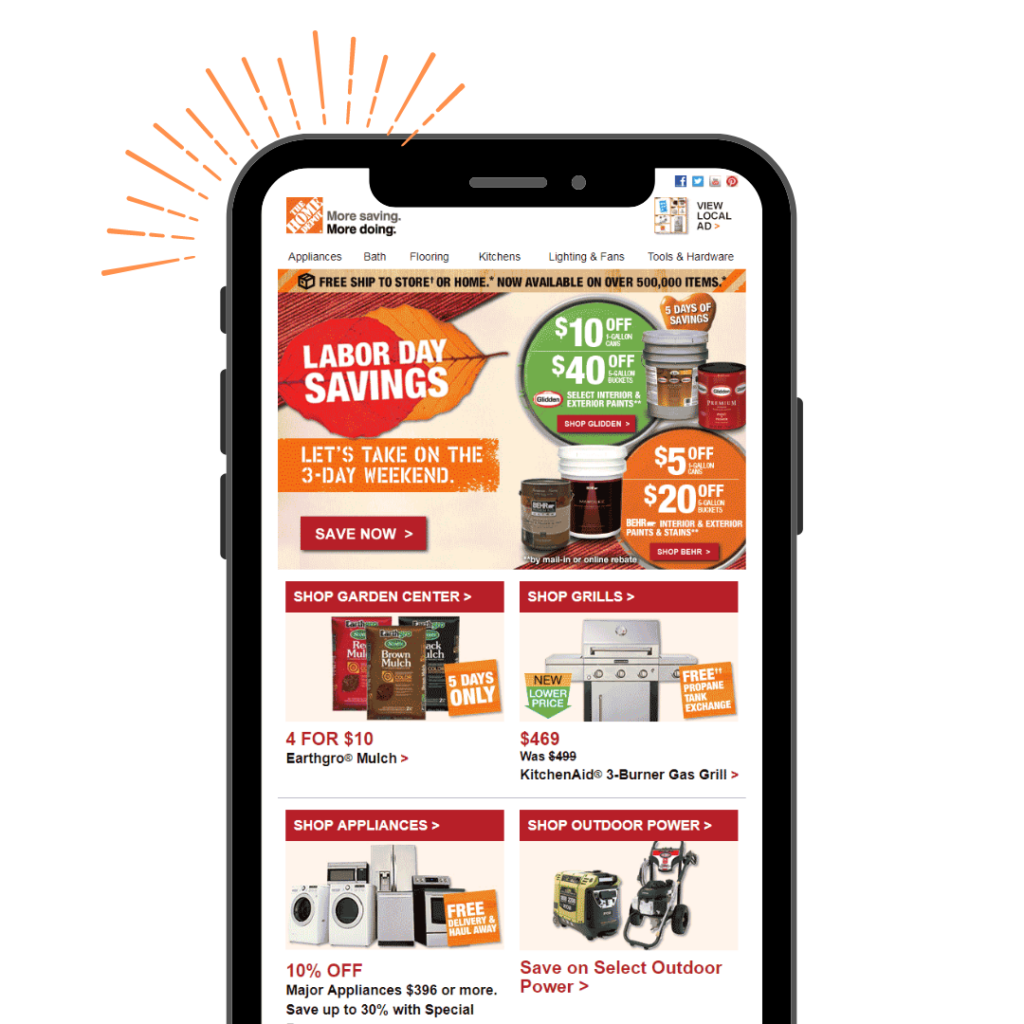
Tip #1 Start By Advertising Your Top Selling Products
My first tip is to start advertising with your top-selling products. I know this might seem a little strange. You might be thinking, Why should I advertise the products that are already selling well? Stay with me here.
Advertising your top-selling products on Home Depot allows you to get a better idea of how to allocate your budget for the products you are more likely to have success with. As you gain experience advertising through Home Depot and collect more data, you’ll be able to optimize and make changes to your advertising strategy to achieve a more positive ROAS.
Bonus Tip: Mature Product Spotlight Strategy
Feature your mature products in seasonal campaigns or emphasize their versatility to reignite consumer interest and boost sales. Also, leveraging customer reviews and ratings effectively can create a sense of authenticity and trustworthiness for both new and mature products.
Tip #2: Get Creative With Underperforming Products
Once you’ve started to gain some traction on Home Depot, it’s time to utilize the platform for the products that aren’t performing as well. A new Home Depot advertising campaign can provide underperforming products with a fresh push in the consumer spotlight.
Through precise category targeting and appealing ad placements, products that may have previously gone unnoticed can gain a new lease on attention.
Bonus Tip: Be Super Specific With Your Product Category
When you create your campaigns, select the category most relevant to the product(s) you want to advertise. That way, your products will be more aligned with the customers who are searching for those specific products.
For example, if you’re selling doors, don’t place it under the paint category. Yes, a door could be painted. But if the future buyer is looking for paint for their living room, they’re probably not going to look twice at your door ad—and that decreases your ROAS.
Tip #3: Take Advantage of the Retail Media+ Product Content Lab
All retail networks require high-quality images, and Home Depot is no different. An ad is no good if the viewer can’t see what they’re being told to purchase.
However, not every company has a team of skilled content creators available to take high quality images and develop masterful visualizations. Retail Media+ knows this, and, in turn, helps with The Home Depot Content Lab.
This solution allows you to create dynamic content at scale, with everything from product information page imagery, copy, demo videos and more. You may need to hire a photographer for initial product images if you don’t already have them. But that one-time investment is small compared to what you can then do with those images inside Home Depot’s advertising platform.
How to Optimize Your Product Listing on Home Depot

Crafting optimized listings that engage your audience and entice them to buy is an art. Here’s how you can master it:
Keyword Targeting
Cherry-picking the right keywords for your product is the first and most important step for advertising in Home Depot’s Retail Media+, or any other platform for that matter.
Your keywords should be highly relevant terms that your customers are likely to use when searching for products like yours. Incorporating long-tail and short-tail keywords judiciously into your product titles, descriptions, and elsewhere in the listing helps improve visibility and search ranking.
(Psst: A long-tail keyword is a specific search phrase that typically contains three or more words and targets a niche demographic rather than mass audiences. A short-tail keyword is one or two words.)
Negative Keyword Strategy
Identifying and incorporating negative keywords can help curtail irrelevant ad spend. A negative keyword is any term that you do not want your ad to appear for, ensuring your message reaches only those actively seeking your products or services. By honing in on the queries that yield little to no return, you can cut down on wasted budget and make the most of your investment for better traffic quality.
Quality, Descriptive Imagery
Words are important, but more often than not, it’s the images that do the talking.
As mentioned, Home Depot’s ad platform requires high-resolution images that showcase your product from various angles, close-ups of important features, and in-context shots. Don’t stop at the primary image; fill out the entire carousel with visuals that tell a story. You can get help with this in the Retail Media+ Content Lab.
Mobile Optimization
According to data from SEMRush, nearly 61% of consumers are visiting homedepot.com from their mobile phones. That means optimizing your content for mobile is arguably more important than for web. Fortunately, Home Depot’s advertising platform will handle most of the visual logistics of this for you.
Getting Positive Reviews
Positive reviews significantly influence purchasing decisions; A 2023 survey revealed 93% of consumers admit their purchase decisions are shaped by reviews, and this number bumps to 98% for unknown brands or products that are more expensive. Here’s how to encourage customer feedback:
- Don’t pop the review request too soon. Give your customers a chance to receive and interact with your product before asking for feedback. A week to ten days post-purchase is a good range.
- Make it easy to leave a review. Consumers are busy, so they’re more likely to leave a review if it’s quick and simple to do so. Offer clear instructions and one-click options for them to rate products and leave feedback.
- Offer incentives (but don’t be sleazy). Offering a discount or special promotion for leaving a review not only boosts your review count, but can also drive repeat business. But don’t make the incentive the focus of your request or it may come across as insincere. (Home Depot has its own Reviewer Program, but it’s unclear how the retailer chooses which products are a part of that program.)
- Explain why reviews are important. When customers buy a product, they’re not always thinking about the humans (like you) behind the brand or other humans who may be in need of the product. Explaining how taking two minutes out of their day can improve the lives of other humans will be incentive enough for many customers.
Home Depot Ad Placement By Type
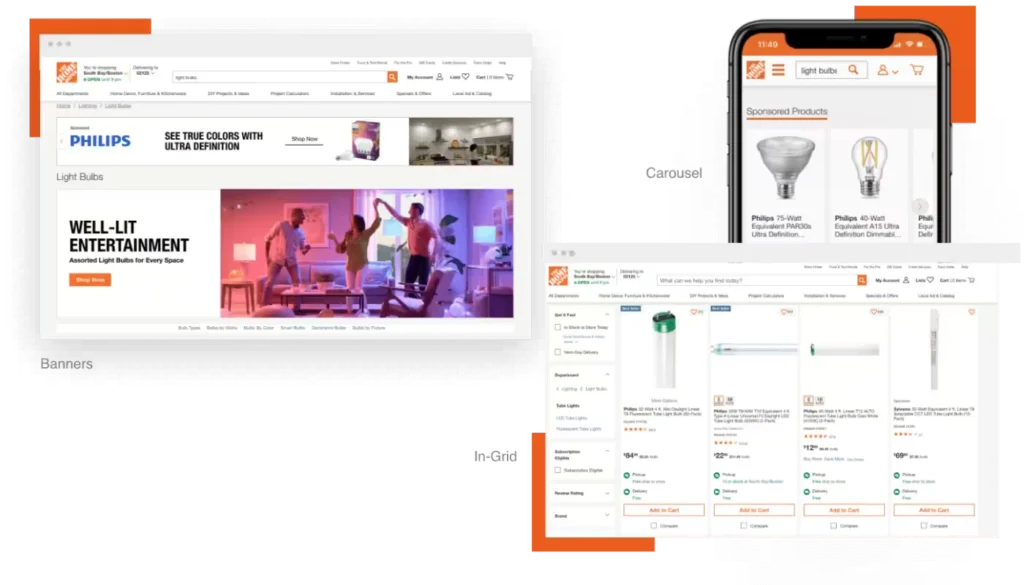
Sponsored Brand ads and Sponsored Product ads are the two pillars of the Home Depot advertising platform. Both types of ads serve different purposes, but ultimately work together to drive sales and increase brand visibility.
Sponsored brand ads are often displayed at the top of the page and (as the name implies) highlight your brand. These ads can highlight your brand’s values, product range, and unique selling points. Sponsored Brand ads not only direct customer traffic but also play a pivotal role in establishing and fortifying brand loyalty and recognition — a great strategy if your goal is for increased brand visibility.
Sponsored product ads are typically more discreetly placed within search results and categories and have an express purpose of driving a sale. These placements are most effective when targeting customers with high purchase intent, as they are more likely to make a purchase when presented with a relevant and visually appealing ad. By combining both sponsored brand and product ads, advertisers can maximize their reach and effectiveness on the Home Depot platform.
Measuring Home Depot Advertising Performance
It’s hard to achieve success with Home Depot advertising if you don’t really know what success looks like. (Aside from the money rolling in, of course). Below, we define some of the top key performance indicators (KPIs) to help you better understand how your campaign is performing.
- Clicks: It measures the amount of time a homedepot.com visitor clicks on your ad. Low or no clicks might mean your bids are too low, and you should raise them. It might also mean your ads are targeting the wrong category. Make sure to double-check that your product belongs to the category you have selected your products to show.
- Ad impressions: How many times your ads have been shown. As such, a low impression volume means your ads aren’t being shown enough.
- Click-through rate (CTR): This is the division between clicks and impressions, giving us a sense of how relevant your ads are to your audience. A CTR lower than 1% means that ads are showing, but not many people click on them, which tells us your ads are not appealing to the audience. A CTR above 1.5% is generally positive.
- Conversion rate (CVR): This metric measures how much of your products have been sold. The higher the number, the higher the number of orders you received.
- Cost per conversion: This is the division between your total ad spend and the number of orders sold. The higher the dollar amount, the higher the cost of products sold.
- Conversion rate: This measures how efficient your campaigns are at converting traffic into customers. It is obtained by dividing the amount of conversion by the number of clicks ads receive.
- ROAS: We’ve already defined ROAS, but it’s worth re-mentioning because it’s the main metric to follow in retail marketing. It measures how efficient campaigns are at driving return on ad spend. To get your ROAS, divide your total revenue by ad total spend. The lower the ROAS percentage, the lower your return is, so you want a high percentage. You want to aim for a ROAS over 100%.
Let’s Build Your Home Depot Advertising Strategy
That was a lot to take in, but no good advertising campaign was born overnight. How many of these tips will you follow for Home Depot advertising success?
Retail Media+ allows you to analyze data and quickly detect what is and what isn’t working, which is a huge benefit. Don’t be afraid of making changes to your campaigns if you are not seeing results. And if the changes you make don’t work, guess what? You’ll learn that quickly and can revisit your strategy again.
If you need help setting up your Home Depot advertising account or if you’re interested in teaming up with Home Depot marketing experts for strategy consultation, scaling, and guidance, let us know! Our retail media team knows Home Depot advertising well, so you can skip the learning curve and achieve better return on your ad spend faster.
Your success is our main goal, and we have a proven track record for helping our clients achieve major results. For example, SKL Home achieved a 3500% increase in weekly orders and 350% annual growth in units sold after partnering with Search Nurture.
Ready to build a fool-proof Home Depot advertising strategy? Schedule a call today to meet the team and get a complimentary advertising analysis.
Home Depot Advertising FAQ
What makes Home Depot’s advertising platform different?
While most other retail platforms target keywords on a CPC (cost-per-click) level, Home Depot gives brands the ability to target specific categories related to the brand’s unique products. It also allows brands to place their products on Home Depot’s main (non-category) pages.
What mistakes do people make when it comes to Home Depot advertising?
Many ecommerce companies will target all available categories within a campaign and will fail to optimize bids on the product level. Search Nurture believes in targeting only the categories that are relevant to the brand’s goals to ensure marketing dollars are spent in the most efficient manner. We pay close attention to target and product performance alike.
How does Search Nurture’s experience with Home Depot’s advertising contribute to clients’ success?
We take the time to thoroughly analyze multiple data points to optimize product listing ads and banner campaigns and eliminate the guesswork of bid changes. Plus, our campaign organization allows us to drive traffic to the most relevant category targets. Our account managers are proficient in the Home Depot advertising interface, and we stay on top of any changes and updates that happen within the platform, so you don’t have to.





